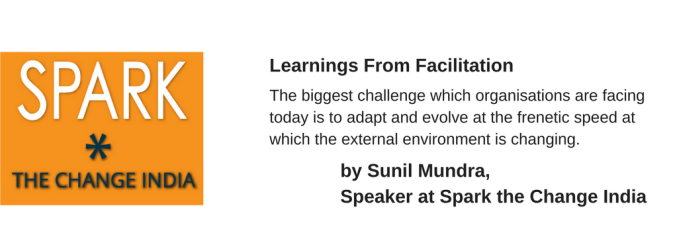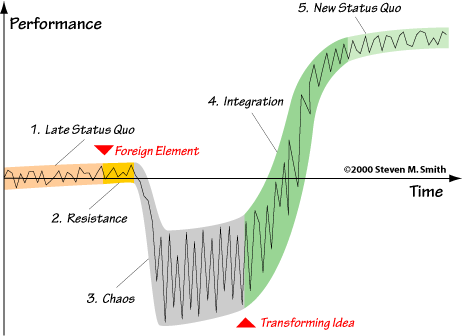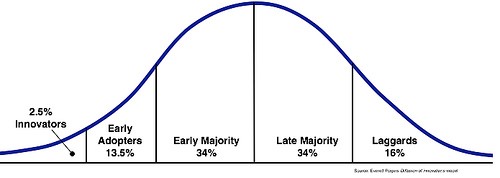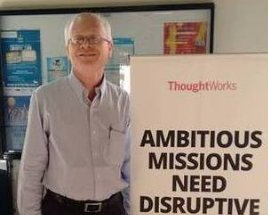
The biggest challenge which organisations are facing today is to adapt and evolve at the frenetic speed at which the external environment is changing. Most organisations find change difficult due to the disruptions caused by the change, which generally result in people having to step out of their comfort zone, thereby creating feelings of uncertainty and fear. Moreover, leaders need to demonstrate courage, conviction, empathy and patience to manage the turbulence arising from change.
Robin Sharma has so aptly said “Change is hard at the beginning, messy in the middle and gorgeous at the end”[i].
What makes matters even more complicated is that this change cycle, as stated by Robin Sharma, is continuous in nature and the pace of the rollover off the cycle will only get faster going forward.
The following are my learnings from facilitating change across multiple organisations:
1. People do not resist Change
A commonly held belief is that, in general, people’s instinct is to resist change. What is supposedly seen as resistance is actually people’s reaction to the potentially negative impact of change on them. It is therefore obvious that if people believe that the change is beneficial for them, they will not react negatively towards it. It can thus be concluded that resistance to change is a myth. It can also be inferred that the so called resistance is just a symptom of an underlying problem.
Some of the causes of ‘resistance’ include:
- Disappointment and resentment about not having a voice in shaping the nature of change
- Processing information about the change selectively, influenced by past bad experience and mental models
- Uncertainty, leading to insecurity, about how the change will impact them
- Realisation that the change will expose their incompetence
- Fear of unknown
Each of these will need a specific way to for preventing and/or overcoming them. E.g. for the first point, opportunities should be provided to people to be heard about shaping the change, before rolling the change out formally. For the third point, it will be a combination of communication regarding the benefits of change for the people and individual counselling.
The key takeaway about resistance is that it should be viewed as a valuable feedback. The feedback could be that the message about the change is not properly understood, the impact of the change is perceived as negative by some individuals or a group of individuals or just that some people are resisting change simply due to a bad attitude. Depending on what the resistance is actually translating into, corrective actions can be determined. It is therefore critical that resistance not be ignored, or even worse, quashed.
2. Be Prepared for ‘The Valley of Despair’
In a book published in 2015, German authors Klaus Leopold and Siegfried Kaltenecker note that the dip in performance in the change curve occurs when the change necessitates that the people in the organisation have to unlearn old behaviors, processes and systems and learn new ways of doing things.
One thing which all Change Models depict is the ‘Valley of Despair’. The Satir Model[ii], as shown below, depicts this trough. The Valley of Despair reflects that things usually will get worse before they get better with respect to any change. In this phase, individuals experience negative emotions like Anxiety and Fear, and the organization experiences slowdown in throughput and responsiveness. There is a lot of uncertainty, and sometimes even chaos, in this phase as both the organization as a whole and the individuals are grappling with eliminating behaviors, processes, practices and simultaneously adopting new behaviors, processes etc. This changeover is disruptive and thus results in negative emotions for the individuals and a slowdown for the organization.

The ‘Valley of Despair’ phase has multiple implications:
- The investment of both time and effort will be high
- Difficult to climb out of the valley if it gets too deep
- Facilitating Change can become the highest priority for the organization, overriding even business priorities
- Treat this as an opportunity to weed out and modify what does not seem to be working well.
- Learnings from dealing with this phase should help to modify the roll-out of change across the wider organization
3. Watch Out For Change Fatigue
Most people find it difficult to deal with change, at least in the initial period, as it entails people stepping out of their comfort zone. This is especially true when the change is intrinsic in nature. Moreover, change can be stressful as it can create insecurity about the job and the role and also self-doubt about adapting to the changed circumstances. To top this, change can be slow and gradual, resulting in people not being able to see the ‘light at the end of the tunnel’. All of this can result in ‘Change Fatigue’ for individuals and teams, and if this fatigue becomes widespread at the organization level, it can negatively impact the adaptiveness of the organization.
Some fatigue at individual and team level will be unavoidable, especially if the change is significant at the organization level. What is important is to spot the fatigue early and implement measures to contain it.
Visible signs of change fatigue include all symptoms of continuous stress and anxiety, increase in absenteeism, cynicism in conversations, and increased apathy in meetings and group discussions.
Following are some measures to avoid/contain change fatigue:
- Provide outlets for people to express their feelings, especially negative ones. Providing access to internal and/or external counselors, anonymized qualitative surveys, ‘all hands’ meetings can help people to bring out their feelings in the open and also provide valuable feedback to the leadership.
- Celebrate successes. These could be in terms of milestones, business impact, behaviours etc.
- Ensure that ‘Innovators’ and ‘Early Adopters’ continue to maintain and radiate their enthusiasm through closer participation in leadership meetings, providing opportunities to drive communication and messaging around change in the wider organization etc. Since these people are usually ‘Opinion Leaders’, any change fatigue in them will have a cascading impact on the wider organization.
- Avoid starting too many big changes at the same time. Spreading the start of some initiatives over a few weeks may make a marginal difference strategically, but can be key in avoiding fatigue.
- Avoid communication overload, particularly which comes from the ‘top’. Choice of timing and a balanced mix of formal and informal communication can ensure that ‘noise’, which can cause fatigue, is avoided.
4. Don’t ‘Steamroll’ the ‘Laggards’
The Technology Adoption Life-cycle Curve[iii], as depicted below, also applies to Intrinsic Change.

In any adoption initiative, including change, every organization will have people falling into each of these 5 categories, but not necessarily will the curve be a bell shaped curve. Laggards are those who are most resistant to adopting change. In this state, they will adopt change only as a last resort, i.e. only when non adoption threatens their survival or identity. It is quite easy for this group to not be noticed in the initial stages, as their resistance may not be overt right away.
Someone can be a Laggard primarily due to either feelings of fear and insecurity arising from change or bad attitude. It is important to identify which of these is the case, as the treatment would be different for each.
It may be tempting to overlook this group of people, as they appear to be a small minority. However, doing so carries a huge risk that many of these people, particularly those with a bad attitude can turn into a ‘bad apples’. The impact of being a ‘bad apple’ is not limited to just that person but has a negative impact at a much wider level, and therefore identifying and dealing with the negative attitudes and behaviors at the earliest is essential.
While a bad attitude may need a tough stand, fears and insecurities need to be treated with sensitivity and patience. Laggards can provide perspectives on roadblocks and challenges, both current and potential, which might be completely overlooked by the vast majority. Hence, the group of Laggards deserves as much attention as the ‘Innovators’, who are on the other extreme of the adoption curve.
5. Don’t ‘Shoot the Enablers’
This is borrowed from the ‘shoot the messenger’ metaphor. Moving to an Adaptive state can cause underlying problems to surface very early, particularly when adopting Agile practices. E.g. After implementing Continuous Integration (CI), the feedback on whether a check in has broken the build will be known immediately. This fast feedback should actually encourage the developers to check in code frequently. However, if the developers are measured based on number of successful and failed check ins, CI may actually discourage the developers from checking in frequently. The problem is not the change from No CI to having CI or the behavior post the change. Introducing CI is actually pointing towards at least 2 underlying problems-measurement which punish the right behavior and lack of safety nets for developers like Test Driven Development (TDD), which encourage the right behaviors.
In this instance, rolling back the CI implementation would be a grave mistake, as it is an enabler which has exposed the problems which, if resolved, will increase the organizations’ Adaptability.
6. Inculcate Sense of Purpose over Sense of Urgency
Many traditional Change Models advocate creating a sense of urgency as the first step in the change process. The primary intent is right-to help people see the need for change. The belief also is that by doing this, change can be speeded up.
However, there are several problems with urgency being the primary driver, some of the key ones being:
- People are inclined to take shortcuts
- It discourages creativity and holistic thinking, as the focus is on ‘just getting it done’
- It can create a sense of panic, leading to knee jerk reactions
- Urgency implies a need to be always busy, and hence people become more keen to be ‘seen’ as busy, which has potential to introduce behavioural anti patterns
A better first step is to create a Sense of Purpose. This would help to understand the need for change even better, as it would give a better understanding of the expected outcomes and behaviors. The intrinsic motivation and therefore the ownership of change will be higher, as purpose more likely to resonate with people rather than urgency.
Getting consensus on the problem statement is the first step towards creating sense of purpose. This may not be as straightforward as people’s perception of the nature and gravity of the problem is found to differ considerably. Many times, investing in workshops to get to a common understanding of the problem becomes an absolute necessity.
A sense of purpose will not only automatically bring in the sense of urgency, but, more important, will lead to solutions based on good judgement.
Of course, focusing on sense of purpose does not mean that complacency should be allowed to creep in.
7. Clarity on ‘What’s in it for me?”
Intrinsic driven changes are meaningful and sustainable at an organization level when every impacted individual in the organization can clearly answer the question ‘what’s in it for me?’ for themselves. Conviction about the change and true buy in for the change will come only when an individual can answer the question unambiguously.
Answering this question, especially for major changes like culture and structure, is a matter of both perception and reality. E.g. regarding learning new skills, some may see it as a dilution of their core skill while others may see it as an addition to their existing skills. Unless the individual is able to see the potential gains of change being higher than the potential to lose, intrinsic change within the individual is unlikely to happen. For individuals to truly buy into the change and align themselves fully to make it happen, the change has to appeal to both the head and the heart.
A combination of organization, team and individual level 2-way communication is needed to achieve this soon. The proportion of investment in individual communication and counselling will depend on which group in the adoption curve the individual belongs to, and generally the investment will be higher as one moves towards the right on the curve.
Sunil Mundra
Principal Consultant, Thoughtworks
Twitter Handle: @sunil_mundra

[i] http://www.aleanjourney.com/2015/07/lean-quote-change-is-hard-at-beginning.html
[ii] https://stevenmsmith.com/ar-satir-change-model/
[iii] https://en.wikipedia.org/wiki/Technology_adoption_life_cycle
A very nice write up. Made for a good read… Thanks to Shalini who forwarded this to me…
I am choosing to share my two cents, here they are
1. No amount of communication is enough.
2. Nothing moves without the support of the top leadership again this depends on the magnitude of change.
3. I liked the WIIFT point.
4. Sense of urgency to me is a way to accentuate the purpose, it is necessary, also it does give a fair idea to people as to what is in it for the org which then gives them an idea of how they can get affected.
it is also needed because people do not leave their comfort zones till the time they are not inconvenienced. Most changes are an attempt to stay competitive as an organization and also as a resource of an organization. the sense of urgency bodes well in this dimension.
5. The despair is an evident event but can be assuaged through small wins, good advertising is important, what ever ground is broken in the journey towards change should be cascaded to bring people out of despair. This also helps to provide second thoughts to the late movers (as you mentioned laggards)
6. the most important point to me is to institutionalize change, in form of processes, policies etc.
Regards
Amit Anand
LikeLiked by 1 person
Hi Amit,
Thank you for your compliment and valuable feedback.
Regards,
Sunil
LikeLiked by 1 person
Very good points, Sunil.
Very well structured too.
During my own experience in facilitating a large change across the organisation, I dwelled on Sense of Urgency for the organisation, and dwelled a little more on Sense of Purpose for the People.
I think both are important, and they complement each other.
LikeLiked by 1 person
Thanks for your very gracious feedback Sunil.
Purpose over Urgency is meant to be read similar to how the Agile Manifesto values are read, i.e. ‘while there is value in items on the right, we value the items on the left more’.The balance between the twwo should be driven by context.
LikeLike